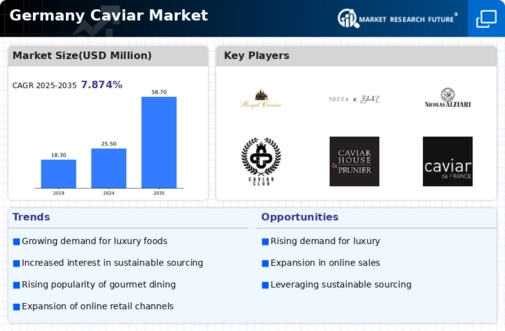The caviar market in Germany exhibits a dynamic competitive landscape characterized by a blend of traditional craftsmanship and modern innovation. Key growth drivers include increasing consumer interest in gourmet foods, rising disposable incomes, and a growing trend towards sustainable sourcing. Major players such as Bester Caviar (DE), Caviar House & Prunier (GB), and Petrossian (FR) are strategically positioned to leverage these trends. Bester Caviar (DE) focuses on local production and sustainability, while Caviar House & Prunier (GB) emphasizes premium quality and luxury branding. Petrossian (FR) combines heritage with modern marketing strategies, enhancing its appeal to a broader audience. Collectively, these strategies contribute to a competitive environment that is both fragmented and rich in innovation.
In terms of business tactics, companies are increasingly localizing manufacturing to reduce costs and enhance supply chain efficiency. The market structure appears moderately fragmented, with several key players vying for market share. This fragmentation allows for niche players to thrive, while larger companies optimize their operations to maintain competitive advantages. The collective influence of these key players shapes market dynamics, as they adapt to consumer preferences and regulatory changes.
In October 2025, Bester Caviar (DE) announced a new partnership with local aquaculture farms to enhance its sustainable sourcing practices. This strategic move not only strengthens its supply chain but also aligns with the growing consumer demand for ethically sourced products. By fostering local partnerships, Bester Caviar (DE) positions itself as a leader in sustainability, potentially attracting environmentally conscious consumers.
In September 2025, Caviar House & Prunier (GB) launched a digital marketing campaign aimed at younger demographics, utilizing social media platforms to promote its luxury offerings. This initiative reflects a broader trend towards digital transformation within the industry, as companies seek to engage with a tech-savvy audience. The campaign's success could significantly enhance brand visibility and customer engagement, thereby driving sales growth.
In August 2025, Petrossian (FR) expanded its product line to include a range of flavored caviars, catering to evolving consumer tastes. This diversification strategy not only broadens its market appeal but also positions Petrossian (FR) to capture a larger share of the gourmet food segment. The introduction of innovative flavors may attract new customers and encourage repeat purchases, thereby enhancing overall profitability.
As of November 2025, current competitive trends in the caviar market include a strong emphasis on digitalization, sustainability, and the integration of advanced technologies. Strategic alliances are increasingly shaping the landscape, as companies collaborate to enhance their product offerings and market reach. Looking ahead, competitive differentiation is likely to evolve, with a shift from price-based competition towards innovation, technology, and supply chain reliability. Companies that prioritize these aspects may find themselves better positioned to thrive in an increasingly competitive environment.

















Leave a Comment